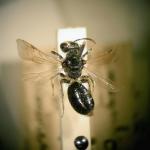The inclusion of this bee on the British list rests on a female in the F. Smith Collection in the University Museum, Oxford. The only documentation carried on the pin is “16.8.”. According to R.C.L. Perkins (1914) the specimen was probably sent to Smith by J.B. Bridgman of Norwich as the pin, mode of setting and label is similar to that of other Andrena known to have been sent by him to Smith in the period 1875-77. The numerals “16.8” presumably indicates the date. This specimen is not mapped.
This is a very rare, local and little known bee though widely distributed throughout much of Eurasia, from Sweden to France and Italy, east to the far east of the Russian Federation (Dylewska, 1987; Gusenleitner & Schwarz, 2002; Ascher & Pickering, 2012).
More pictures and notes can be found on Steven Falk's Flickr site.
Shirt (1987) and Falk (1991) both list this species as Extinct (Appendix) in Britain (assuming it was ever established).
Little information is available. In Sweden a typical habitat has been described as being a small meadow or forest edge sheltered from wind and cooling by surrounding trees and bushes (L.A. Nilsson, pers. comm.).
Univoltine; July and August.
In Sweden nests occur either singly or in small, loose aggregations in exposed light soil (L.A. Nilsson, pers. comm.).
Burnet-saxifrage, wild angelica, wild carrot.
No data available.
2018


